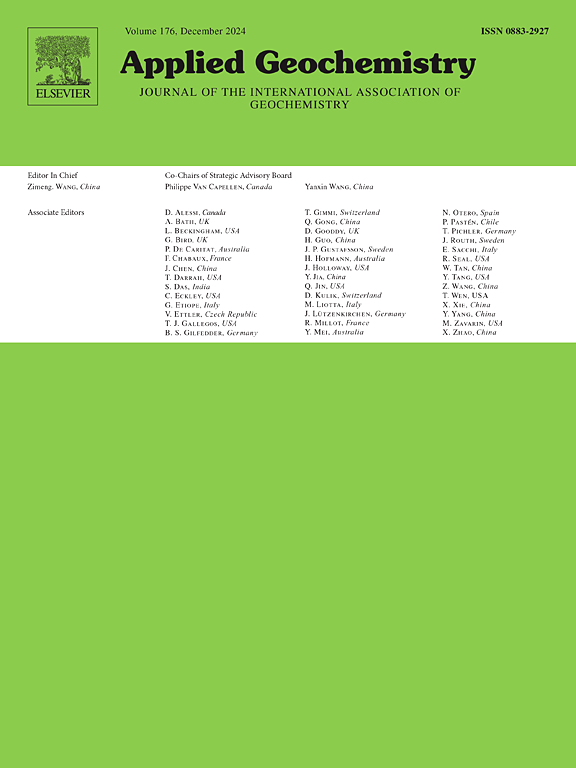Unraveling hydrogen induced geochemical reaction mechanisms through coupled geochemical modeling and machine learning
IF 3.4
3区 地球科学
Q1 GEOCHEMISTRY & GEOPHYSICS
引用次数: 0
Abstract
Underground hydrogen storage (UHS) provides a promising large-scale, long-term energy storage solution. A reasonable recovery of stored hydrogen is critical for a successful storage scheme. However, in subsurface reservoirs hydrogen is subject to active geochemical reactions that might result in hydrogen loss. In this study, we implemented a geochemical modeling approach coupled with an unsupervised machine learning technique called non-negative matrix factorization (NMF) to unravel the complex brine-rock-H2 geochemical processes responsible for hydrogen losses, with particular focus on sulfate reduction reactions. NMF is applied to modeled mineral evolution and fluid component profiles to retrieve profiles that can be interpreted to more easily assess competing processes. NMF decouples simulated competing equilibrium reactions. This facilitates separation of overlapping reaction profiles from redox processes, dissolution fronts, and secondary precipitation while considering the effects of simulation parameters such as salinity, temperature, and total H2 pressure. NMF successfully discriminates these competing effects in nonlinear ways, allowing robust interpretation. In addition, NMF reveals subtle coupled mineral associations and reaction fronts that are invisible to conventional model analysis. This integrated approach strengthens the conceptual understanding of complex nonlinear hydrogen-brine-rock interactions and advances geochemical research on UHS systems to resolve complexities in modeled geochemical systems without the need for direct experiments or prior knowledge. This study highlights the efficacy of combining geochemical modeling with machine learning techniques to enhance the interpretability of the intricate geochemical simulation output through deciphering the overlapping reaction path that cannot be achieved only using conventional analysis of geochemical models alone.
通过耦合地球化学建模和机器学习揭示氢诱导的地球化学反应机制
地下储氢(UHS)提供了一个有前途的大规模、长期的能源储存解决方案。合理回收储存的氢对于成功的储存方案至关重要。然而,在地下储层中,氢受到活跃的地球化学反应的影响,可能导致氢的损失。在这项研究中,我们实施了一种地球化学建模方法,并结合了一种称为非负矩阵分解(NMF)的无监督机器学习技术,以揭示导致氢损失的复杂盐水-岩石- h2地球化学过程,特别是硫酸盐还原反应。NMF应用于模拟的矿物演化和流体成分剖面,以检索可以解释的剖面,从而更容易地评估竞争过程。NMF解耦模拟竞争平衡反应。这有助于从氧化还原过程、溶解前沿和二次沉淀中分离重叠的反应剖面,同时考虑到盐度、温度和总H2压等模拟参数的影响。NMF以非线性的方式成功地区分了这些相互竞争的影响,从而实现了稳健的解释。此外,NMF揭示了传统模型分析看不到的微妙的耦合矿物关联和反应前沿。这种综合方法加强了对复杂非线性氢-盐水-岩石相互作用的概念理解,并推进了UHS系统的地球化学研究,以解决模拟地球化学系统的复杂性,而无需直接实验或先验知识。本研究强调了地球化学建模与机器学习技术相结合的有效性,通过破译重叠反应路径来提高复杂的地球化学模拟输出的可解释性,这是仅使用常规地球化学模型分析无法实现的。
本文章由计算机程序翻译,如有差异,请以英文原文为准。
求助全文
约1分钟内获得全文
求助全文
来源期刊

Applied Geochemistry
地学-地球化学与地球物理
CiteScore
6.10
自引率
8.80%
发文量
272
审稿时长
65 days
期刊介绍:
Applied Geochemistry is an international journal devoted to publication of original research papers, rapid research communications and selected review papers in geochemistry and urban geochemistry which have some practical application to an aspect of human endeavour, such as the preservation of the environment, health, waste disposal and the search for resources. Papers on applications of inorganic, organic and isotope geochemistry and geochemical processes are therefore welcome provided they meet the main criterion. Spatial and temporal monitoring case studies are only of interest to our international readership if they present new ideas of broad application.
Topics covered include: (1) Environmental geochemistry (including natural and anthropogenic aspects, and protection and remediation strategies); (2) Hydrogeochemistry (surface and groundwater); (3) Medical (urban) geochemistry; (4) The search for energy resources (in particular unconventional oil and gas or emerging metal resources); (5) Energy exploitation (in particular geothermal energy and CCS); (6) Upgrading of energy and mineral resources where there is a direct geochemical application; and (7) Waste disposal, including nuclear waste disposal.
 求助内容:
求助内容: 应助结果提醒方式:
应助结果提醒方式:


